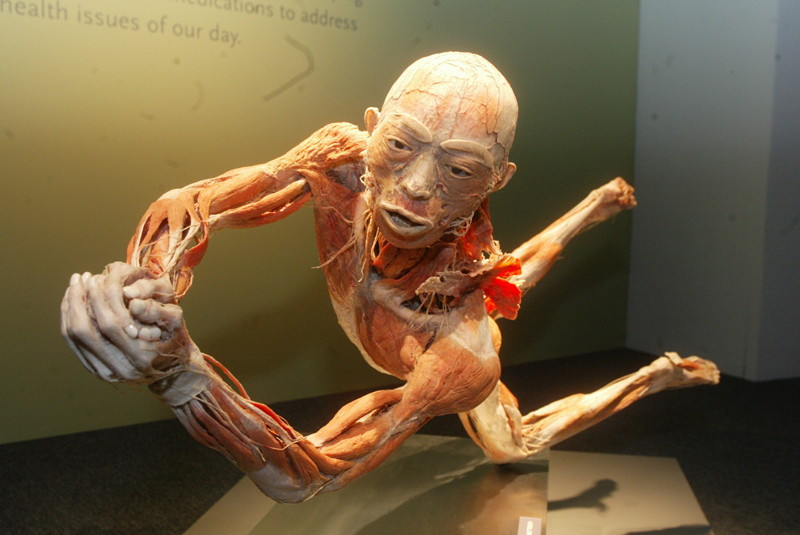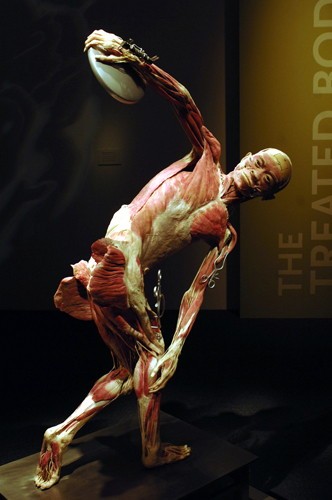Embracing the end of someone else’s life
For a culture seemingly detached from death, why are we eager to line up to see an exhibit of dead bodies?
There is no doubt about it – Bodies… The Exhibition brings controversy along with it wherever it goes, and Winnipeg is no exception.
But, why are Winnipeggers lining up to see an exhibit of the dead?
“We’re not particularly interested in our own but we certainly do embrace all aspects of death,” said Dr. Barnett Richling, chair of Anthropology at the University of Winnipeg, noting the number of Americans who profess a belief in ghosts, and our culture’s recent obsession with zombies.
“Death factors pretty fundamentally in the development of human culture, and certainly in the development of our value systems and our whole notion of what is sacred and so on.”
Bodies features nearly 200 bodies and body parts that have been dissected to show how the musculature works, and to expose various parts of the body that would only ever be seen by medical students and coroners.
The bodies have been preserved using a technique called polymer preservation, where all the water is extracted and replaced with a plastic, giving the pieces a waxy feel, and making them last indefinitely.
The exhibit, which is presented by Atlanta-based company Premier Exhibitions, Inc., has been seen by more than 15 million people across the globe, including exhibits in New York, Las Vegas, Washington, London, Sao Paulo, Barcelona, Amsterdam, Vienna and Prague.
It has also garnered considerable controversy surrounding where the bodies come from. Both Seattle and Paris have banned the exhibit because of rumours the bodies could be victims of Chinese execution and torture.
Premier Exhibitions is adamant that the bodies died from natural causes.
Politics aside, Richling notes that we are always keen to see if there’s a body lying in the street when there has been an accident.
“ Mutilating bodies and cutting them up is a part of Christianity. Pieces of saints were preserved and they became relics and they had power. A finger, a heart, a bone, sometimes pieces of clothing too – saints and venerated people were often really chopped up.
Dr. David Topper, art history professor, University of Winnipeg
“People are just interested in the experience of seeing bodies, naked or otherwise, and that’s probably a greater part of our culture these days than any kind of inhibition about seeing these things.”
We can also look to Christianity and other cultures for reactions to death. Painters in the Christian world have been painting the crucifixion of Jesus for centuries, while saints and venerated people have pieces of themselves in buildings around the world.
“Mutilating bodies and cutting them up is a part of Christianity,” explained Dr. David Topper, who teaches art history at the U of W.
“Pieces of saints were preserved and they became relics and they had power. A finger, a heart, a bone, sometimes pieces of clothing too – saints and venerated people were often really chopped up.”
Some cultures have much stronger rules regarding death than we do, Richling adds.
“There are some cultures where there are actually very strong injunctions about being in contact with the dead, even in some traditional cultures once a person dies you’re not allowed to say their name, even the name is taboo.”
But overall, both experts agree that we react differently to the exhibit knowing the bodies are real, rather than if it consisted of models.
“When they’re art pictures you look at them in a different way,” says Topper. “We look at images and we don’t quite see them as real things, we see them as images. Nude pictures don’t really cause that much of a fuss unless there’s some kind of sexual activity involved.
“Whereas photographs have a whole different world … I don’t know if knowing what you know you can see (the bodies) as art objects.”
“Then, there are going to be people who say: it’s like a form of art,” he continueed. “The body is beautiful in its design, and it makes you think about how complex we actually are with all the bits and pieces, and by showing bodies in action you get a sense of what’s what and how it works and you can see where things are that could go wrong with you and so on.”
Bodies… The Exhibition runs through January 2011 at the MTS Exhibition Centre at 311 Portage Ave. Tickets are $15.95 for students and seniors, and $19.95 for adults, and are available at Ticketmaster.ca or by calling 780-3333. For more about the exhibit, visit www.bodieswinnipeg.com.
Published in Volume 65, Number 4 of The Uniter (September 23, 2010)








